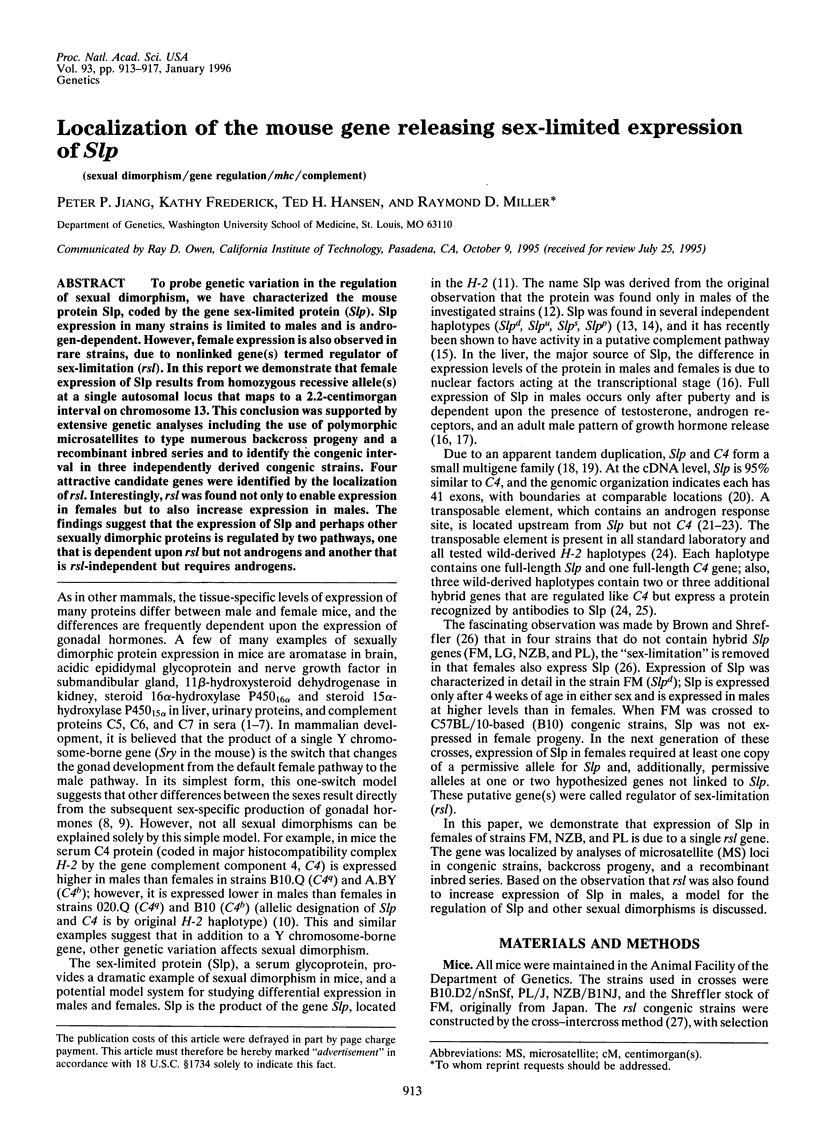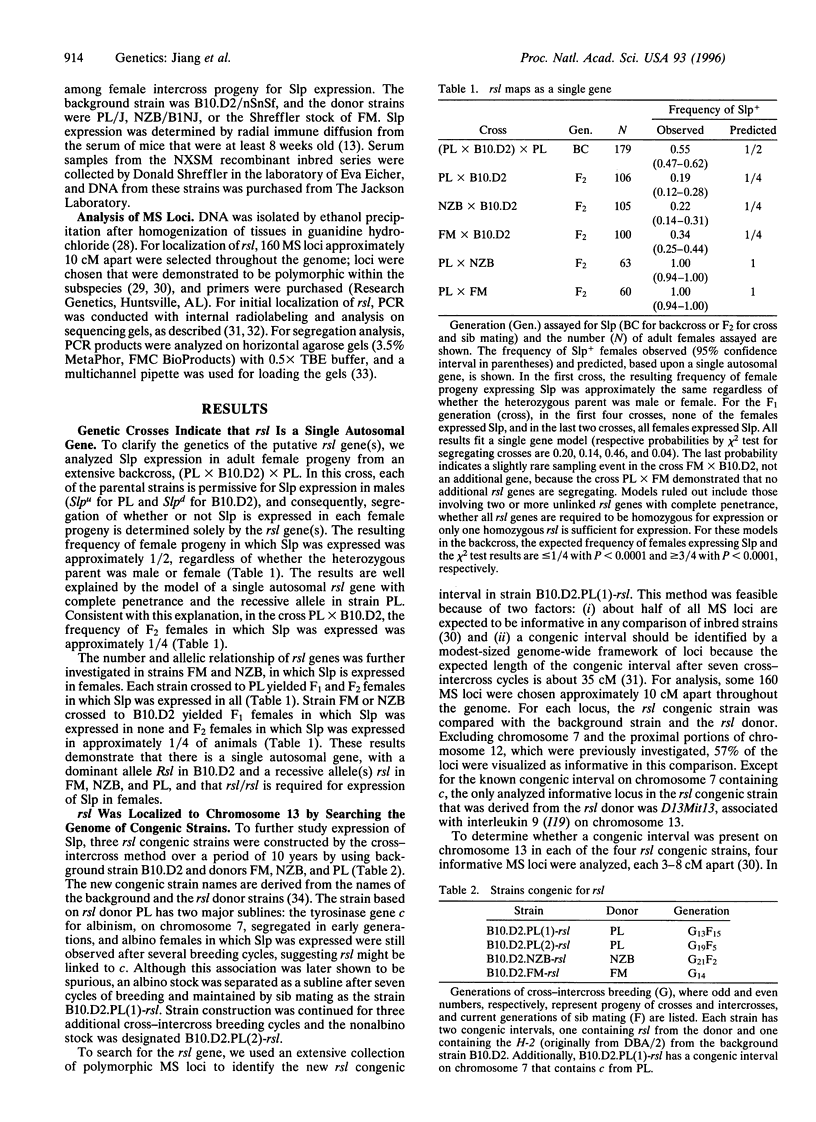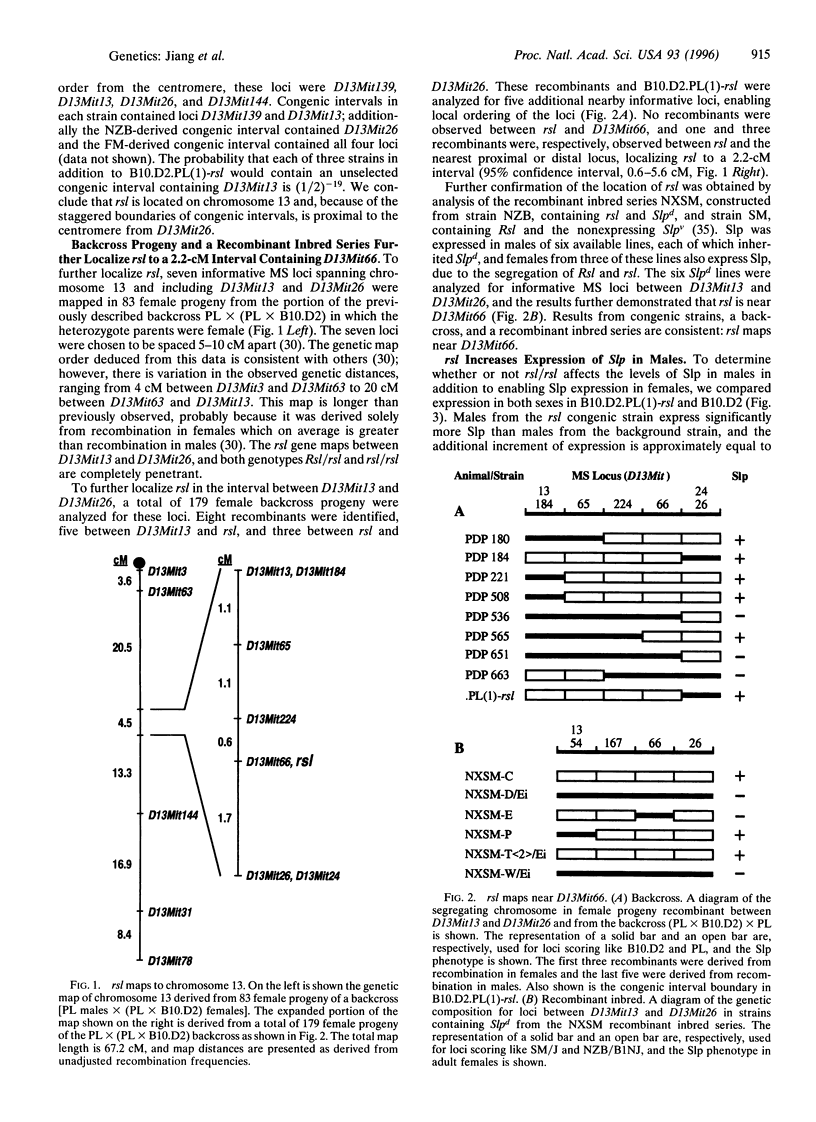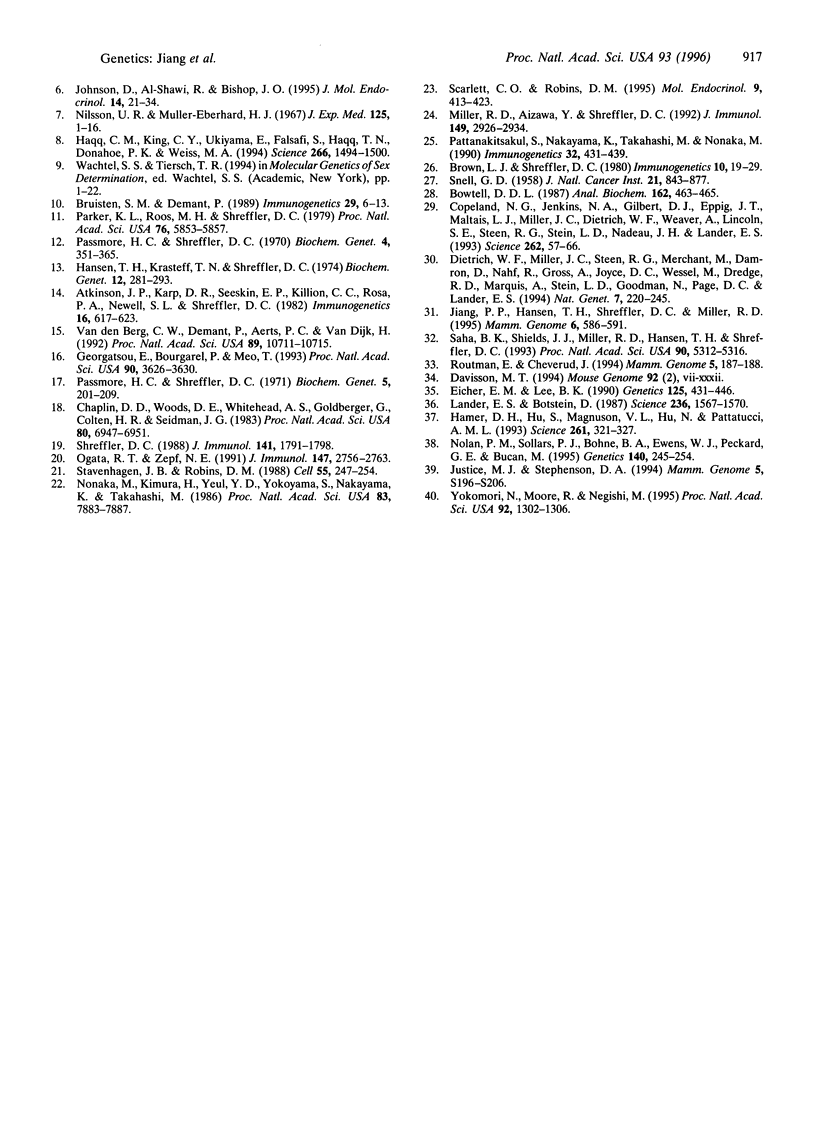Abstract
To probe genetic variation in the regulation of sexual dimorphism, we have characterized the mouse protein Slp, coded by the gene sex-limited protein (Slp). Slp expression in many strains is limited to males and is androgen-dependent. However, female expression is also observed in rare strains, due to nonlinked gene(s) termed regulator of sex-limitation (rsl). In this report we demonstrate that female expression of Slp results from homozygous recessive allele(s) at a single autosomal locus that maps to a 2.2-centimorgan interval on chromosome 13. This conclusion was supported by extensive genetic analyses including the use of polymorphic microsatellites to type numerous backcross progeny and a recombinant inbred series and to identify the congenic interval in three independently derived congenic strains. Four attractive candidate genes were identified by the localization of rsl. Interestingly, rsl was found not only to enable expression in females but to also increase expression in males. The findings suggest that the expression of Slp and perhaps other sexually dimorphic proteins is regulated by two pathways, one that is dependent upon rsl but not androgens and another that is rsl-independent but requires androgens.
Full text
PDF




Selected References
These references are in PubMed. This may not be the complete list of references from this article.
- Atkinson J. P., Karp D. R., Seeskin E. P., Killion C. C., Rosa P. A., Newell S. L., Shreffler D. C. H-2 S region determined polymorphic variants of the C4, Slp, C2, and B complement proteins: a compilation. Immunogenetics. 1982;16(6):617–623. doi: 10.1007/BF00372032. [DOI] [PubMed] [Google Scholar]
- Black M. A., Lefebvre F. A., Pope L., Lefebvre Y. A., Walker P. Thyroid hormone and androgen regulation of nerve growth factor gene expression in the mouse submandibular gland. Mol Cell Endocrinol. 1992 Mar;84(1-2):145–154. doi: 10.1016/0303-7207(92)90081-g. [DOI] [PubMed] [Google Scholar]
- Bowtell D. D. Rapid isolation of eukaryotic DNA. Anal Biochem. 1987 May 1;162(2):463–465. doi: 10.1016/0003-2697(87)90421-0. [DOI] [PubMed] [Google Scholar]
- Brown L. J., Shreffler D. C. Female expression of the H-2-linked sex-limited protein (Slp) due to non-H-2 genes. Immunogenetics. 1980;10(1):19–29. doi: 10.1007/BF01561549. [DOI] [PubMed] [Google Scholar]
- Bruisten S. M., Demant P. Regulation of expression of mouse C4 and Slp genes by non-H-2-linked genes. Immunogenetics. 1989;29(1):6–13. doi: 10.1007/BF02341607. [DOI] [PubMed] [Google Scholar]
- Chaplin D. D., Woods D. E., Whitehead A. S., Goldberger G., Colten H. R., Seidman J. G. Molecular map of the murine S region. Proc Natl Acad Sci U S A. 1983 Nov;80(22):6947–6951. doi: 10.1073/pnas.80.22.6947. [DOI] [PMC free article] [PubMed] [Google Scholar]
- Copeland N. G., Jenkins N. A., Gilbert D. J., Eppig J. T., Maltais L. J., Miller J. C., Dietrich W. F., Weaver A., Lincoln S. E., Steen R. G. A genetic linkage map of the mouse: current applications and future prospects. Science. 1993 Oct 1;262(5130):57–66. doi: 10.1126/science.8211130. [DOI] [PubMed] [Google Scholar]
- Dietrich W. F., Miller J. C., Steen R. G., Merchant M., Damron D., Nahf R., Gross A., Joyce D. C., Wessel M., Dredge R. D. A genetic map of the mouse with 4,006 simple sequence length polymorphisms. Nat Genet. 1994 Jun;7(2 Spec No):220–245. doi: 10.1038/ng0694supp-220. [DOI] [PubMed] [Google Scholar]
- Eicher E. M., Lee B. K. The NXSM recombinant inbred strains of mice: genetic profile for 58 loci including the Mtv proviral loci. Genetics. 1990 Jun;125(2):431–446. doi: 10.1093/genetics/125.2.431. [DOI] [PMC free article] [PubMed] [Google Scholar]
- Georgatsou E., Bourgarel P., Meo T. Male-specific expression of mouse sex-limited protein requires growth hormone, not testosterone. Proc Natl Acad Sci U S A. 1993 Apr 15;90(8):3626–3630. doi: 10.1073/pnas.90.8.3626. [DOI] [PMC free article] [PubMed] [Google Scholar]
- Hamer D. H., Hu S., Magnuson V. L., Hu N., Pattatucci A. M. A linkage between DNA markers on the X chromosome and male sexual orientation. Science. 1993 Jul 16;261(5119):321–327. doi: 10.1126/science.8332896. [DOI] [PubMed] [Google Scholar]
- Hansen T. H., Krasteff T. N., Shreffler D. C. Quantitative variations in the expression of the mouse serum antigen Ss and its sex-limited allotype Slp. Biochem Genet. 1974 Oct;12(4):281–293. doi: 10.1007/BF00485949. [DOI] [PubMed] [Google Scholar]
- Haqq C. M., King C. Y., Ukiyama E., Falsafi S., Haqq T. N., Donahoe P. K., Weiss M. A. Molecular basis of mammalian sexual determination: activation of Müllerian inhibiting substance gene expression by SRY. Science. 1994 Dec 2;266(5190):1494–1500. doi: 10.1126/science.7985018. [DOI] [PubMed] [Google Scholar]
- Hutchison J. B., Beyer C., Green S., Wozniak A. Brain formation of oestrogen in the mouse: sex dimorphism in aromatase development. J Steroid Biochem Mol Biol. 1994 Jun;49(4-6):407–415. doi: 10.1016/0960-0760(94)90287-9. [DOI] [PubMed] [Google Scholar]
- Jiang P. P., Hansen T. H., Shreffler D. C., Miller R. D. Mouse H2 congenic intervals: analysis and use for mapping. Mamm Genome. 1995 Sep;6(9):586–591. doi: 10.1007/BF00352362. [DOI] [PubMed] [Google Scholar]
- Johnson D., al-Shawi R., Bishop J. O. Sexual dimorphism and growth hormone induction of murine pheromone-binding proteins. J Mol Endocrinol. 1995 Feb;14(1):21–34. doi: 10.1677/jme.0.0140021. [DOI] [PubMed] [Google Scholar]
- Justice M. J., Stephenson D. A. Mouse chromosome 13. Mamm Genome. 1994;5(Spec No):S196–S206. [PubMed] [Google Scholar]
- Lander E. S., Botstein D. Homozygosity mapping: a way to map human recessive traits with the DNA of inbred children. Science. 1987 Jun 19;236(4808):1567–1570. doi: 10.1126/science.2884728. [DOI] [PubMed] [Google Scholar]
- Miller R. D., Aizawa Y., Shreffler D. C. Restriction fragment length polymorphism of the murine C4 and Slp genes: two C4 groups. J Immunol. 1992 Nov 1;149(9):2926–2934. [PubMed] [Google Scholar]
- Mizuki N., Kasahara M. Mouse submandibular glands express an androgen-regulated transcript encoding an acidic epididymal glycoprotein-like molecule. Mol Cell Endocrinol. 1992 Nov;89(1-2):25–32. doi: 10.1016/0303-7207(92)90207-m. [DOI] [PubMed] [Google Scholar]
- Nilsson U. R., Müller-Eberhard H. J. Deficiency of the fifth component of complement in mice with an inherited complement defect. J Exp Med. 1967 Jan 1;125(1):1–16. doi: 10.1084/jem.125.1.1. [DOI] [PMC free article] [PubMed] [Google Scholar]
- Nolan P. M., Sollars P. J., Bohne B. A., Ewens W. J., Pickard G. E., Bućan M. Heterozygosity mapping of partially congenic lines: mapping of a semidominant neurological mutation, Wheels (Whl), on mouse chromosome 4. Genetics. 1995 May;140(1):245–254. doi: 10.1093/genetics/140.1.245. [DOI] [PMC free article] [PubMed] [Google Scholar]
- Nonaka M., Kimura H., Yeul Y. D., Yokoyama S., Nakayama K., Takahashi M. Identification of the 5'-flanking regulatory region responsible for the difference in transcriptional control between mouse complement C4 and Slp genes. Proc Natl Acad Sci U S A. 1986 Oct;83(20):7883–7887. doi: 10.1073/pnas.83.20.7883. [DOI] [PMC free article] [PubMed] [Google Scholar]
- Ogata R. T., Zepf N. E. The murine Slp gene. Additional evidence that sex-limited protein has no biologic function. J Immunol. 1991 Oct 15;147(8):2756–2763. [PubMed] [Google Scholar]
- Parker K. L., Roos M. H., Shreffler D. C. Structural characterization of the murine fourth component of complement and sex-limited protein and their precursors: evidence for two loci in the S region of the H-2 complex. Proc Natl Acad Sci U S A. 1979 Nov;76(11):5853–5857. doi: 10.1073/pnas.76.11.5853. [DOI] [PMC free article] [PubMed] [Google Scholar]
- Passmore H. C., Shreffler D. C. A sex-limited serum protein variant in the mouse: hormonal control of phenotypic expression. Biochem Genet. 1971 Apr;5(2):201–209. doi: 10.1007/BF00485645. [DOI] [PubMed] [Google Scholar]
- Passmore H. C., Shreffler D. C. A sex-limited serum protein variant in the mouse: inheritance and association with the H-2 region. Biochem Genet. 1970 Jun;4(3):351–365. doi: 10.1007/BF00485752. [DOI] [PubMed] [Google Scholar]
- Pattanakitsakul S., Nakayama K., Takahashi M., Nonaka M. Three extra copies of a C4-related gene in H-2w7 mice are C4/Slp hybrid genes generated by multiple recombinational events. Immunogenetics. 1990;32(6):431–439. doi: 10.1007/BF00241638. [DOI] [PubMed] [Google Scholar]
- Rajan V., Chapman K. E., Lyons V., Jamieson P., Mullins J. J., Edwards C. R., Seckl J. R. Cloning, sequencing and tissue-distribution of mouse 11 beta-hydroxysteroid dehydrogenase-1 cDNA. J Steroid Biochem Mol Biol. 1995 Feb;52(2):141–147. doi: 10.1016/0960-0760(94)00159-j. [DOI] [PubMed] [Google Scholar]
- Routman E., Cheverud J. A rapid method of scoring simple sequence repeat polymorphisms with agarose gel electrophoresis. Mamm Genome. 1994 Mar;5(3):187–188. doi: 10.1007/BF00352355. [DOI] [PubMed] [Google Scholar]
- SNELL G. D., JACKSON R. B. Histocompatibility genes of the mouse. II. Production and analysis of isogenic resistant lines. J Natl Cancer Inst. 1958 Nov;21(5):843–877. [PubMed] [Google Scholar]
- Saha B. K., Shields J. J., Miller R. D., Hansen T. H., Shreffler D. C. A highly polymorphic microsatellite in the class II Eb gene allows tracing of major histocompatibility complex evolution in mouse. Proc Natl Acad Sci U S A. 1993 Jun 1;90(11):5312–5316. doi: 10.1073/pnas.90.11.5312. [DOI] [PMC free article] [PubMed] [Google Scholar]
- Scarlett C. O., Robins D. M. In vivo footprinting of an androgen-dependent enhancer reveals an accessory element integral to hormonal response. Mol Endocrinol. 1995 Apr;9(4):413–423. doi: 10.1210/mend.9.4.7659085. [DOI] [PubMed] [Google Scholar]
- Shreffler D. C. Seventy-five years of immunology: the view from the MHC. J Immunol. 1988 Sep 15;141(6):1791–1798. [PubMed] [Google Scholar]
- Stavenhagen J. B., Robins D. M. An ancient provirus has imposed androgen regulation on the adjacent mouse sex-limited protein gene. Cell. 1988 Oct 21;55(2):247–254. doi: 10.1016/0092-8674(88)90047-5. [DOI] [PubMed] [Google Scholar]
- Sueyoshi T., Kobayashi R., Nishio K., Aida K., Moore R., Wada T., Handa H., Negishi M. A nuclear factor (NF2d9) that binds to the male-specific P450 (Cyp 2d-9) gene in mouse liver. Mol Cell Biol. 1995 Aug;15(8):4158–4166. doi: 10.1128/mcb.15.8.4158. [DOI] [PMC free article] [PubMed] [Google Scholar]
- Yokomori N., Moore R., Negishi M. Sexually dimorphic DNA demethylation in the promoter of the Slp (sex-limited protein) gene in mouse liver. Proc Natl Acad Sci U S A. 1995 Feb 28;92(5):1302–1306. doi: 10.1073/pnas.92.5.1302. [DOI] [PMC free article] [PubMed] [Google Scholar]
- van den Berg C. W., Démant P., Aerts P. C., Van Dijk H. Slp is an essential component of an EDTA-resistant activation pathway of mouse complement. Proc Natl Acad Sci U S A. 1992 Nov 15;89(22):10711–10715. doi: 10.1073/pnas.89.22.10711. [DOI] [PMC free article] [PubMed] [Google Scholar]


